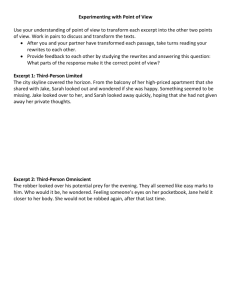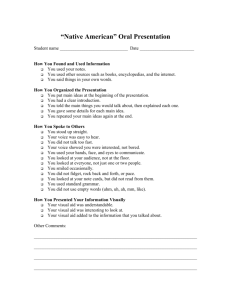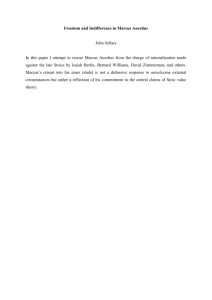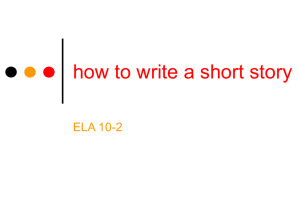Creative Writing
advertisement
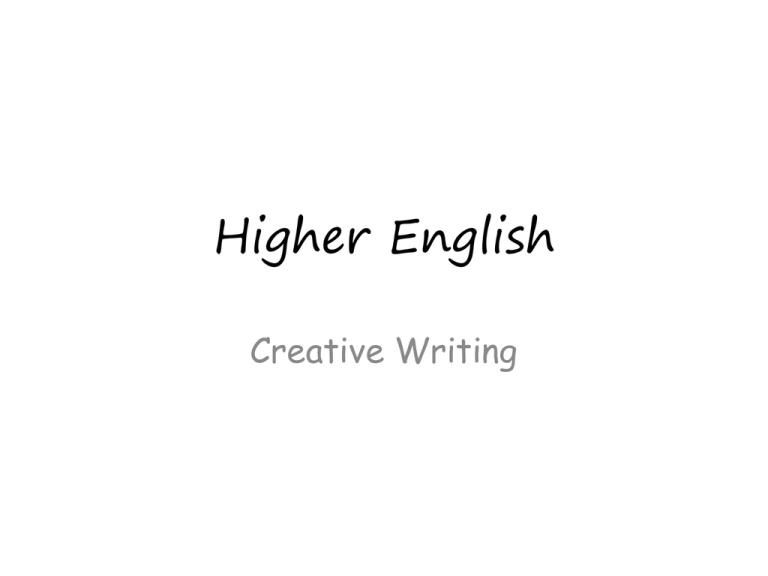
Higher English Creative Writing Writing Tasks • We are going to complete a variety of writing tasks over the next two weeks • We will then look at different forms of creative writing • Start thinking about – Short story – Drama script – First chapter of a novel Objects and characters Choose a number between 1 and 6. This corresponds to a photograph of a character. Write a brief pen portrait of this character. What is their name? What do they do for a living? Where do they live? What kind of lifestyle do they have? How about their personal relationships? You may wish to use the character planning support sheet. 3 2 1 4 3 4 5 5 6 6 Objects and characters Now choose a letter between A and F. This will correspond to an object that has significance for your character. Write a scene from a story in which the character discovers the object after a long time. What emotions, impressions, sensations and secrets does the object evoke for your character? Have a look at the example at the end of the slide show. 7 A – a hair comb B – a mask C – a teddy bear 8 D – a pocket watch E – a violin F – an old tennis racquet 9 ‘Marcus’ The old man had been a hoarder, that was sure. The attic was stuffed full of junk: stuffed with stuff, Marcus thought. He had no idea what he was here for: ‘Have a look in your uncle’s attic,’ his father had said, ‘take whatever you want,’ and he’d felt it would be disrespectful to say that he didn’t want anything, couldn’t possibly have any use for anything a decrepit old hulk who smelled bad and had yellow teeth might have ever possessed. Even the records were junk. Sure, some of them might have been worth something, but Marcus’ specialty was West Coast America, 1958 to the early seventies, an explosion of psychedelia and jangly guitars that he would have certainly missed out on if he hadn’t spent that summer when he was seventeen in the old hippie commune just north of San Angelo, days of painting houses or fixing cars and nights of driftwood fires and lazy beers on the beach. Who the hell was Tab Taylor anyway? Who’d ever heard of Joss Moody and the Pipe Dreamers? Of course, he hadn’t expected to find anything he’d recognise, which meant he almost passed it by, stuck on the undershelf of some mouldy side table, the kind of thing they put doilies on. Then, when he did realise what it was, he’d looked at it suspiciously, like it was a burglar, unwelcome and intrusive. His mother’s violin. In his uncle’s attic. Marcus hadn’t seen it since she’d died, when he was twelve. Sure, he’d looked – looked everywhere in fact – and his father, who by that time had succumbed to the bourbon and didn’t give a damn about her anyway, couldn’t even remember what he was talking about. So how had it come to be here? Stimulus Exercise 4: Which Voice? The Third Person Third-person subjective • In this form of narrative, the story is told in the third person, but from one character's point of view. This is powerful because it means we can develop a character very fully, and it gives the reader someone to follow and empathise with throughout the story. At the same time, it also allows us to distance the reader from the character, much more than if we were writing in the first person. • However, it also has limitations. We cannot jump between characters, so we can never know what someone other than the main character is thinking unless they tell us; it is also stylistically difficult to write scenes in which the main character is not present. • Read the following extracts of this sort of narrative. What can you tell about the characters, about their lives and personalities? 13 'In the kitchen, he poured another drink and looked at the bedroom suite in his front yard. The mattress was stripped and the candystriped sheets lay beside two pillows on the chiffonier. Except for that, things looked much the way they had in the bedroom – nightstand and reading lamp on his side of the bed, nightstand and reading lamp on her side. His side, her side. He considered this as he sipped the whiskey.' Why don’t you dance?, Raymond Carver 'Georgia once took a creative writing course, and what the instructor told her was: too many. Too many things going on at the same time; also too many people. Think, he told her. What is the important thing? What do you want to pay attention to? Think. Eventually she wrote a story about her grandfather killing chickens, and the instructor seemed pleased with it. Georgia herself thought it was a fake. She made a long list of all the things that had been left out and handed it in as an appendix to the story.' Differently, Alice Munro 14 Different third-person perspectives • Choose two numbers between 1 and 6. • These numbers correspond to characters. Write brief pen portraits of them – names, occupations, family, beliefs. Your task is to write about an event from these two different perspectives. 15 1 2 16 3 4 17 5 6 18 Different third-person perspectives • Now choose a letter between A and F. • This corresponds to an event. Your task is to write about this event from the different viewpoints of the two characters. • Your characters can be participants in the event or witnesses. They may even be reflecting on the event long after it has happened. • This is known as the Rashomon effect, from Rashomon, a film by Akira Kurosawa, in which the same story is told from various characters’ perspectives. 19 A. A shop is robbed. B. A collision between two cars occurs in a busy street. C. A political demonstration takes place in a public square. D. A wedding spills out of a church after the service. E. An argument occurs between two people in a public place, such as a restaurant or a shop. F. A storm floods a neighbourhood. 20 Stimulus Exercise 9: To Speak or Not to Speak… Exercises in Dialogue Starting stories with dialogue Here is the opening dialogue from Ernest Hemingway’s The Snows of Kilimanjaro. 'The marvellous thing is that it’s painless,' he said. 'That’s how you know when it really starts.' 'Is it really?' 'Absolutely. I’m awfully sorry about the odour though. That must bother you.' 'Don’t. Please don’t.' 22 • What do you think is happening here? What is the relationship between the two characters? What are the advantages of beginning a story in this way? • Choose a number between 1 and 6. These numbers correspond to pictures of characters. • Open a story with a dialogue in which it is unclear who the characters are and what is happening between them. 23 1 2 24 3 4 25 5 6 26 The Snows of Kilimanjaro For those of you intrigued by the conversation at the beginning of this exercise, here is a plot summary from Wikipedia: The story centres on the memories of a writer named Harry who is on safari in Africa. He develops an infected wound from a thorn puncture, and lies awaiting his slow death. This loss of physical capability causes him to look inside himself — at his memories of the past years, and how little he has actually accomplished in his writing. He realizes that although he has seen and experienced many wonderful and astonishing things during his life, he had never made a record of the events; his status as a writer is contradicted by his reluctance to actually write. He also quarrels with the woman with him, blaming her for his living decadently and forgetting his failure to write of what really matters to him, namely his experiences among poor and 'interesting' people, not the predictable upper class crowd he has fallen in with lately. Thus he dies, having lived through so much and yet having lived only for the moment, with no regard to the future. In a dream he sees a plane coming to get him and take him to the top of Mount Kilimanjaro. 27 Manipulating language • Re-write the following paragraph but try to vary the vocabulary; vary sentence structure and use figurative language. You could also give the man a name and add any other details that you think would be appropriate. You will have 10 minutes to complete this task. Once you are finished swap with a partner and try to identify as many techniques as you can. He walked to the shops. He saw a picture in the window of a girl he once knew. She was missing. He felt sad. He tried to remember the last time he saw her. He wondered if he would ever see her again. Only then did he realise how much he loved her. Writing a Short Story • This is the style you are most familiar with • Think about structure – Opening – Development – Complication – Crisis – Conclusion Drama script • You need to have an idea of the overall plot of your play and where in the play your key scene is going to take place • You need to think about in-depth characterisation and an over-riding theme • You need to focus on developing the story through dialogue – I have an advice sheet available for those wishing to write a drama-script First Chapter of a Novel • You must include a title of your novel and chapter • Have an overall idea of the plot of your novel, the characterisation, the setting and the overriding themes • Your first chapter must be used to develop characterisation and setting; introduce themes and end in a complication that is satisfactory as an ending but also inviting to read on. Criteria: • A sophisticated and stylish piece of writing in which the content is particularly well selected and shows qualities of insight/imagination/sophisticated thought. The structure is highly appropriate and there is skilful organisation which significantly enhances the overall impact of the writing. Expression is concise and effective. Word choice is consistently apposite, and sentence structures are skilfully varied to achieve effects. Techniques associated with the genre are used very effectively. • Imaginative writing in this category will be characterised by a strong sense that the writer has command of and insight into the genre and is skilfully introducing and developing thematic concerns; the writing has flair and individuality which permeate the ideas and use of language.
